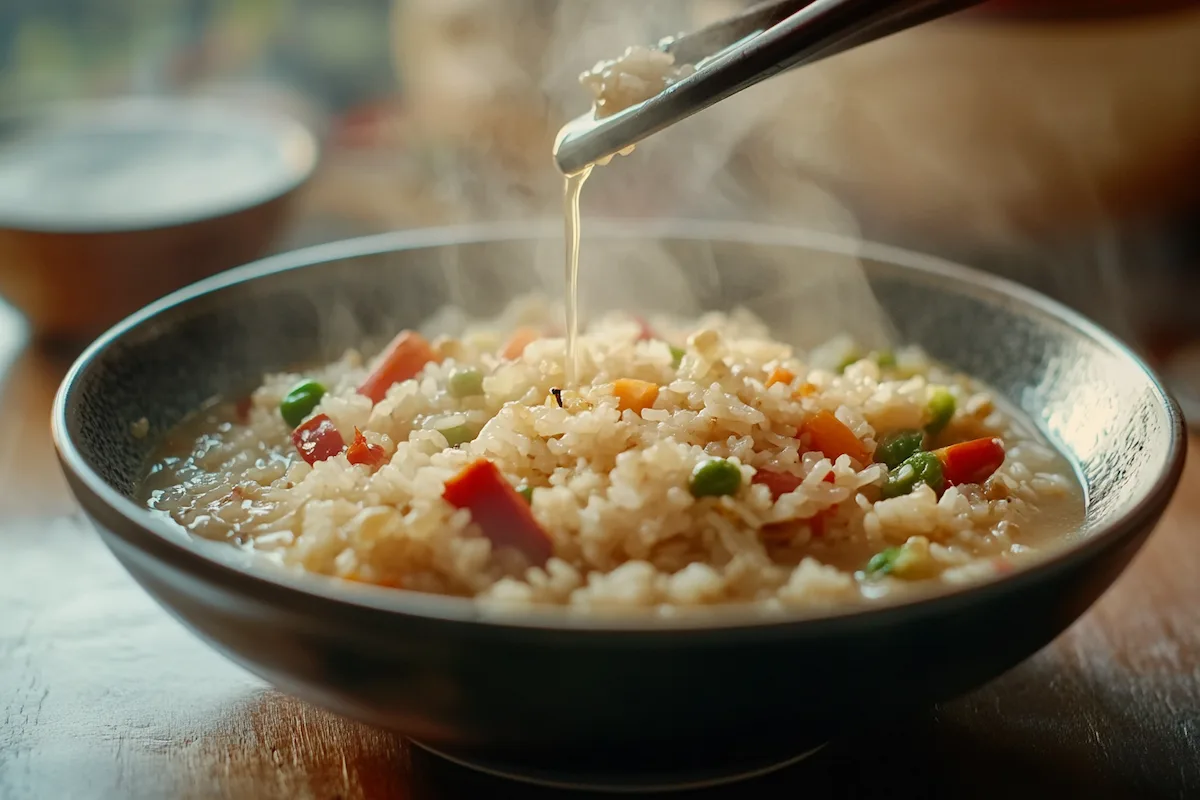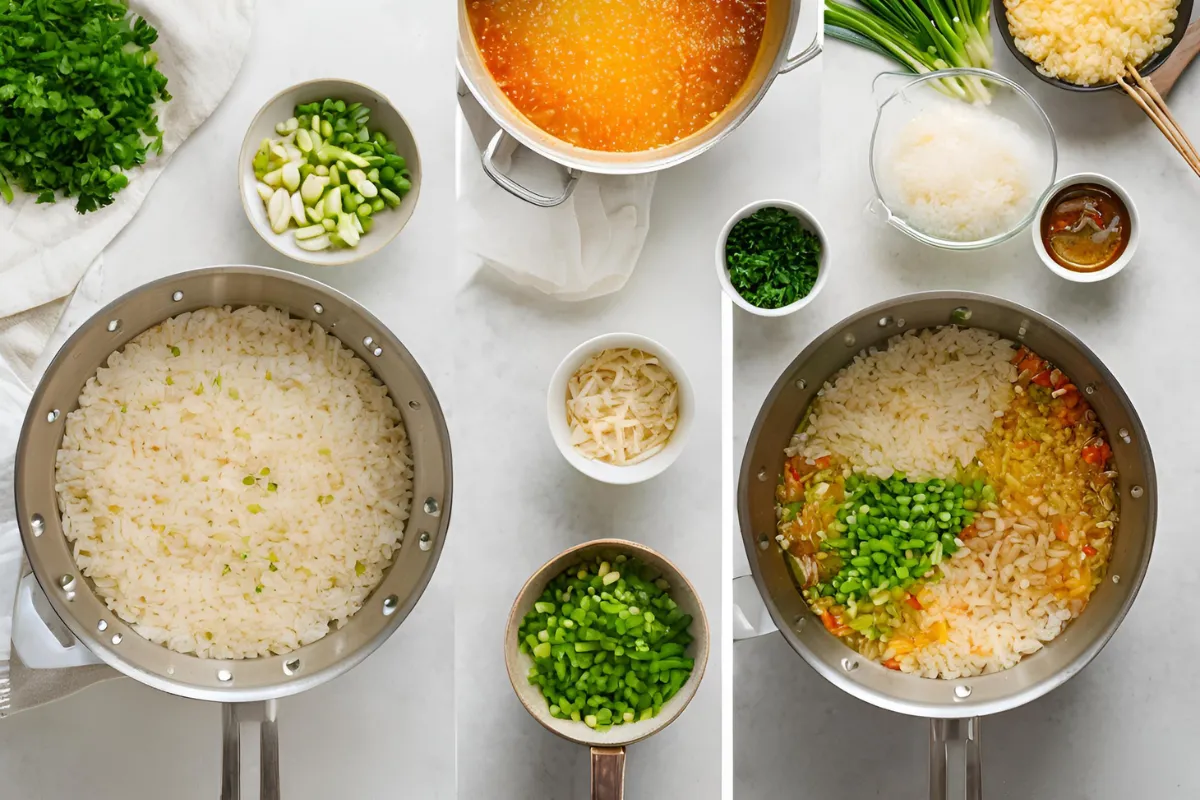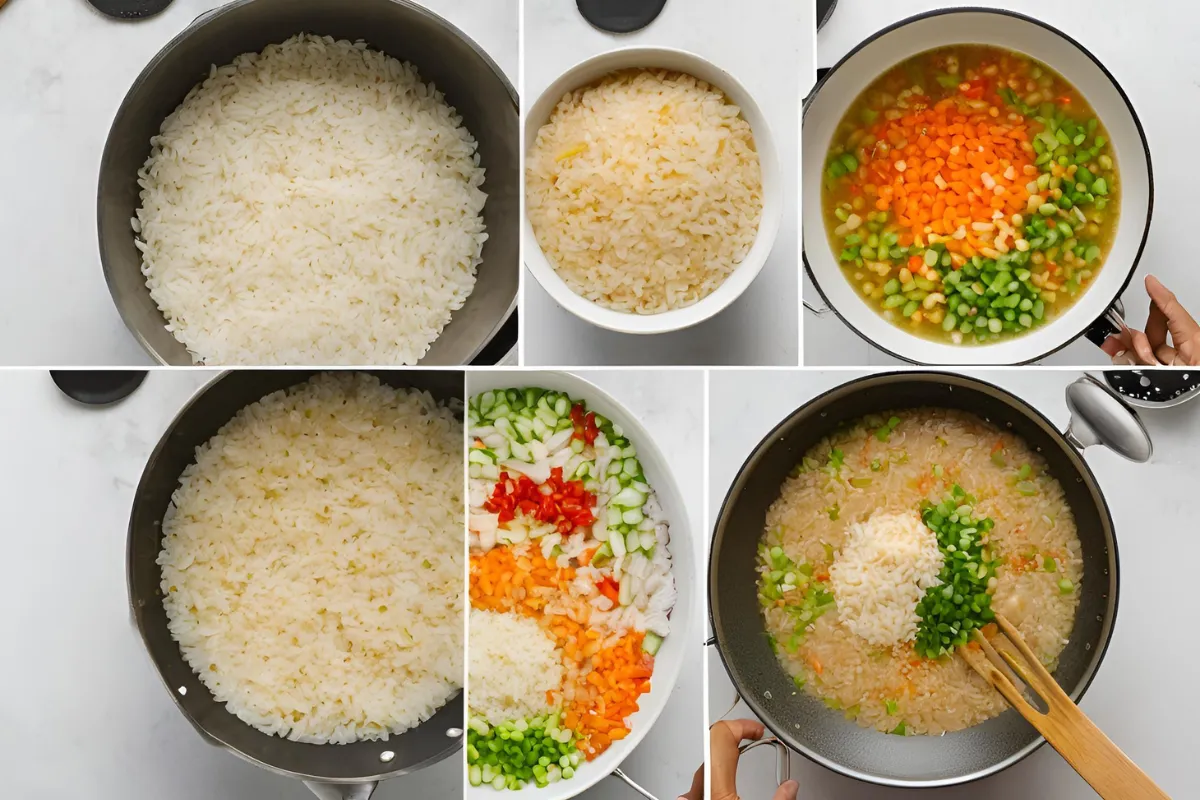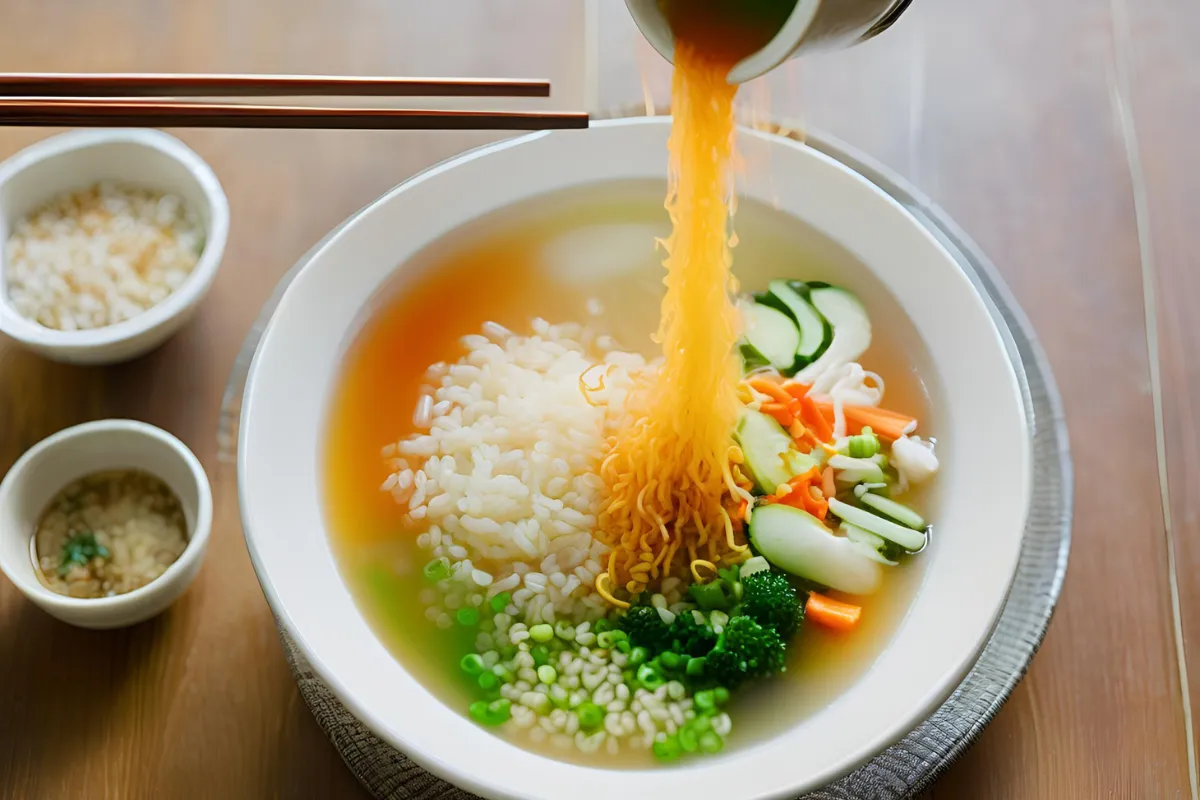Introduction
Sizzling rice soup is an iconic dish that captures the essence of Chinese cuisine. It blends crispy textures and savory broth. The crispy rice sizzles when it hits the hot soup, creating a memorable sound. This dish combines exciting textures and flavors that make it unforgettable.
The soup starts with a crispy rice base and adds savory ingredients. These elements come together for a unique, flavorful experience. If you’ve had it at a restaurant, you’ll likely remember the sizzle. The sound, texture, and taste all contribute to its appeal.
In this article, we’ll explore the key components of sizzling rice soup. We’ll also discuss its origins and how to make it at home. Whether you’re new to the dish or a seasoned fan, this guide will help you discover what makes it special.
What is Sizzling Rice Soup Made Of?
When you first encounter sizzling rice soup, one thing becomes immediately clear – the star of the show is the crispy rice. The concept is simple: a bowl of hot, flavorful broth is poured over crispy, deep-fried rice, creating an incredible contrast in textures. But what is sizzling rice soup made of beyond the crispy rice? Let’s break it down and explore the various ingredients that make this dish a crowd-pleaser.
The Role of Crispy Rice in Sizzling Rice Soup
The crispy rice is key to the dish’s signature sizzle. Chefs cook the rice in oil until golden brown and crunchy, then place it in a serving dish just before adding the broth. When they pour the hot liquid over the rice, it creates an exciting “sizzling” sound. This not only impresses visually but also adds a delightful crispy texture to the soup.
But the crispy rice isn’t just for show – it serves as a flavor carrier. The rice soaks up the broth, giving every bite a burst of flavor. Without this unique ingredient, the soup would be far less exciting. You can imagine how the crispy texture and savory broth come together to create a satisfying, layered dish.
The Broth: The Heart of Sizzling Rice Soup
No sizzling rice soup would be complete without a rich and aromatic broth. This base is often made from chicken or vegetable stock, although variations may include pork or seafood broth. The key is the depth of flavor, which provides a comforting backdrop for the rice and other ingredients.
The broth typically contains soy sauce, sesame oil, ginger, garlic, and sometimes a hint of rice wine for added complexity. It’s this flavorful broth that ties everything together and makes every spoonful feel like a warm, savory hug.
Proteins: Chicken, Shrimp, Tofu, and More
While some versions of sizzling rice soup stick to the traditional use of chicken or shrimp, others get creative with the protein choices. Some people opt for tofu for a vegetarian take, while others add beef, pork, or even fish.
In any case, the proteins are usually sliced thinly and cooked in the broth, allowing them to absorb all the delicious flavors. Whether you prefer tender chicken breast, juicy shrimp, or a hearty tofu option, the protein you choose will complement the crispy rice and broth perfectly, offering a satisfying protein-rich dish.
Vegetables: Fresh and Flavorful
No sizzling rice soup would be complete without a generous serving of vegetables. These add color, texture, and additional layers of flavor. Common vegetables in sizzling rice soup include mushrooms, carrots, snow peas, and bok choy. These ingredients provide both a mild sweetness and a slight crunch, offering a balance to the deep flavors of the broth and crispy rice.
Seasonings: Adding the Finishing Touch
The seasonings are what truly elevate this dish. In addition to the basic ingredients like soy sauce and ginger, many recipes incorporate five-spice powder, star anise, or a dash of white pepper for some heat. These spices work together to create a harmonious blend of flavors that excite your palate without overwhelming it.
Some recipes may even include Chinese rice wine or a dash of hoisin sauce for an extra layer of umami, giving the broth its rich, satisfying taste.
The Ingredients of Sizzling Rice Soup
Sizzling rice soup is a flavorful, textural masterpiece where each ingredient contributes to the overall sensory experience. From the crispy rice to the aromatic broth, every component plays an essential role in making this dish irresistible. Let’s break down the key ingredients that make this soup so special.
Main Ingredients of Sizzling Rice Soup
At the heart of sizzling rice soup are a few core ingredients that make the dish come to life. These are the building blocks that form the base of this comforting dish, combining the perfect balance of texture, taste, and aroma.
The Role of Crispy Rice in the Soup
The crispy rice is the true star of this soup, and it’s what gives sizzling rice soup its signature sizzle. After being deep-fried to a golden brown, the rice takes on a crunchy, crispy texture that contrasts beautifully with the hot, steaming broth. When the hot broth is poured over the crispy rice, it causes a sizzling sound and gives the rice a slightly softened yet still crunchy bite. This sizzling effect creates both a visual spectacle and a multi-textured eating experience.
The crispy rice is not just for drama—it absorbs the flavors of the broth while maintaining its crunch, allowing it to deliver bursts of savory flavor with each bite. This crispy texture adds depth to the soup, making each spoonful an exciting journey of contrast.
Proteins: Chicken, Beef, Shrimp, or Tofu
While traditional sizzling rice soup often includes chicken, you can find a variety of proteins depending on your taste preferences. Shrimp is another common option, adding a touch of sweetness and delicate flavor. For those who prefer a heartier, more savory protein, beef may be used, sliced thinly and quickly cooked in the broth. Vegetarian versions may include tofu, which soaks up the flavors of the broth while offering a softer, more delicate texture.
Each protein choice brings its own unique flavor to the dish. The chicken adds tenderness and mild flavor, while shrimp contributes a sweet, slightly briny taste. Beef lends a richness to the soup, and tofu provides a lighter, creamier contrast.
Vegetables: Mushrooms, Carrots, Snow Peas, and More
The vegetables in sizzling rice soup add both color and texture, helping to round out the dish. Commonly, you’ll find mushrooms, such as shiitake or button mushrooms, which provide an earthy, umami flavor. Carrots contribute a slight sweetness, while snow peas add a fresh, crunchy element.
Other vegetables that can be included are bok choy, which adds a tender bite, and bean sprouts for extra crunch. Together, these vegetables create a beautiful balance of flavors and textures, complementing the richness of the broth and the crispness of the rice.
Broth: How It’s Made
The broth is arguably the soul of sizzling rice soup. Traditionally, it’s made with chicken broth, though you may find variations using vegetable or pork broth to suit different dietary preferences. The broth is rich and savory, flavored with ingredients like soy sauce, sesame oil, ginger, and garlic. These ingredients work together to create a deep, flavorful base that enhances the taste of the proteins, vegetables, and crispy rice.
The key to a perfect broth lies in the balance of flavors. Soy sauce provides saltiness and umami, while sesame oil adds a fragrant nuttiness. Ginger gives the broth warmth, and garlic contributes a savory punch. These seasonings create a harmonious, well-rounded broth that ties all the ingredients together.
Seasonings: Soy Sauce, Sesame Oil, Ginger, and Garlic
No sizzling rice soup would be complete without the proper seasonings. The combination of soy sauce, sesame oil, ginger, and garlic is what makes the soup so deliciously aromatic. These seasonings bring depth and warmth to the dish, allowing the crispy rice and fresh vegetables to shine.
- Soy sauce adds a savory, salty base to the broth, while sesame oil enhances its richness with a nutty aroma.
- Ginger brings warmth and a slightly spicy edge, and garlic gives the soup its signature savory kick.
Together, these seasonings contribute to a complex, umami-rich broth that amplifies the natural flavors of the ingredients, making every spoonful deeply satisfying.
How Ingredients Contribute to the Flavor
The magic of sizzling rice soup lies in the balance of flavors and textures. The crispy rice adds a unique crunch that soaks up the rich broth, delivering both a crunchy and soft texture in every bite. The broth itself, rich with soy sauce and sesame oil, envelops the vegetables and proteins, allowing each ingredient to absorb the flavor and contribute to the overall dish.
What makes the dish even more exciting is the contrast between the hot, sizzling broth and the cold, crispy rice. When the broth is poured over the rice, it creates a moment of sizzling magic, followed by the gradual softening of the rice, which retains just enough crunch to make it interesting. This textural contrast is what makes sizzling rice soup such a unique and comforting meal.
As the broth warms the crispy rice, it also infuses the proteins and vegetables with its flavors. Whether it’s the chicken, shrimp, or tofu, each protein absorbs the rich, savory liquid, giving every bite a burst of flavor. The vegetables, on the other hand, offer a fresh, crisp contrast that balances out the heartiness of the broth and the rice.
With each spoonful, the interplay between the crispy rice, savory broth, tender protein, and fresh vegetables creates a deliciously complex dish that keeps you coming back for more.
How to Make Sizzling Rice Soup at Home
Making sizzling rice soup at home is easier than you might think. With the right ingredients and a little patience, you can recreate this restaurant-worthy dish in your kitchen. Let’s walk through the process step-by-step, so you can enjoy the crispy, sizzling goodness of this popular soup from the comfort of your home.
Step-by-Step Recipe
Prepping the Ingredients: Rice, Proteins, and Vegetables
First things first, you’ll need to prep all your ingredients. For the crispy rice, it’s best to use day-old rice, as it’s drier and fries better than freshly cooked rice. If you don’t have day-old rice, you can also cook rice in advance and let it cool.
Now, let’s focus on the proteins. Choose your favorite protein—chicken, shrimp, tofu, or beef. For chicken, thinly slice the meat into bite-sized pieces. If you’re using shrimp, peel and devein them. For tofu, drain and cut into small cubes.
Next, chop up your vegetables. Mushrooms, carrots, snow peas, and bok choy are excellent options for this soup. Slice the mushrooms and carrots into thin pieces, and set the snow peas and bok choy aside for easy addition later.
Cooking the Broth and Adding Seasonings
In a large pot, prepare your broth. Start by heating chicken or vegetable broth on medium heat. Once it’s hot, add soy sauce, sesame oil, ginger, and garlic to create a rich, flavorful base. You can also add a pinch of white pepper and a dash of rice wine for a bit of extra depth if you like. Let the broth simmer for about 10 minutes, allowing all the flavors to meld together.
While the broth is simmering, you can briefly cook your proteins. If you’re using chicken, sauté it in a little oil until it’s fully cooked. For shrimp, quickly cook them in a hot pan until pink. Tofu can be lightly sautéed as well for added texture.
Frying the Rice for That Crispy Texture
Now it’s time for the crispy rice, which is the star ingredient of sizzling rice soup. In a separate pan, heat some oil over medium-high heat. Add your rice in small batches to avoid overcrowding the pan. Fry the rice until it’s golden brown and crispy, stirring occasionally to ensure an even texture. This usually takes about 5-7 minutes per batch.
Once the rice is crispy, remove it from the pan and set it aside on paper towels to drain any excess oil.
Combining the Ingredients and Serving
Now that all your ingredients are ready, it’s time to assemble the soup. In a large soup bowl or, ideally, a sizzling plate, place a generous portion of the crispy rice. Gently pour the hot broth over the rice, making sure to sizzle the rice and create that iconic sound. Add your cooked proteins and vegetables to the bowl, allowing the broth to warm them through.
Serve immediately, garnishing with some fresh herbs, like cilantro or green onions, if desired.
Tips for Perfecting the Sizzling Effect
How to Properly Heat the Sizzling Plate
To achieve the perfect sizzling effect, you need to heat your serving plate or bowl properly. If you’re using a sizzling plate, place it on a burner over medium heat for about 5 minutes before adding the crispy rice. If you don’t have a sizzling plate, you can use any heatproof dish, but it won’t sizzle quite as dramatically. Once the plate is hot, it will create that irresistible sizzling sound when the broth hits the rice.
Best Practices for Serving
To serve sizzling rice soup like a pro, make sure you do so immediately after the broth is poured over the rice. The crispy rice will soften a little over time, so it’s best enjoyed while the sizzle is still going strong.
You can also serve the soup with extra soy sauce on the side, allowing your guests to add more seasoning to taste. Pair it with some Chinese tea or a light side dish like spring rolls to complete your meal.
Variations of Sizzling Rice Soup Around the World
Sizzling rice soup has its roots in traditional Chinese cuisine, but as with many classic dishes, it has evolved over time and taken on various regional and international forms. Whether you’re in southern or northern China or halfway across the globe in a fusion restaurant, sizzling rice soup continues to delight with its dynamic flavors and textures. Let’s explore how this iconic dish varies by region and culture, and see how creative chefs have put their own spin on it.
Regional Variations in China
Southern and Northern Variations of Sizzling Rice Soup
In China, people enjoy sizzling rice soup across many regions, and its taste and appearance vary. In Southern China, especially in Cantonese cuisine, chefs make lighter, more delicately flavored versions of the soup. The broth is subtly seasoned, focusing on clean, aromatic flavors. These versions often include shrimp, chicken, or fish, along with light vegetables like bok choy and mushrooms. The emphasis is on the broth, allowing the crispy rice to shine.
On the other hand, in Northern China, the version of sizzling rice soup might be a bit heartier. The broth could be richer, flavored with a more generous amount of soy sauce, ginger, and garlic, and sometimes spiced with a hint of five-spice powder. Northern variations may also include a broader variety of vegetables like carrots and snow peas, and proteins such as beef or even lamb. Northern Chinese sizzling rice soup is often more robust, with thicker, more savory broths that complement the crispy rice with a fuller, deeper flavor.
In both regions, the crispy rice remains the central component, and the sizzling effect is as vital as ever. However, the flavor profile and the ingredients may differ depending on the regional approach.
Use of Different Proteins and Vegetables
The proteins used in sizzling rice soup can vary widely across China. While chicken and shrimp are popular choices, some regions lean toward more exotic proteins like duck, beef, or even pork. In the southern regions, seafood such as abalone and scallops may be used for a more luxurious, delicate touch. Meanwhile, tofu is a common vegetarian protein used across all regions of China, offering a soft, creamy texture that complements the crispy rice beautifully.
Vegetables also vary by region, with the southern versions favoring bok choy, snow peas, and shiitake mushrooms, while the north includes heartier vegetables such as carrots, corn, and cabbage. Some variations may also include fermented vegetables or pickles for an added tanginess, which adds complexity to the dish.
International Adaptations
Sizzling Rice Soup in Places Like Hong Kong, Taiwan, and Beyond
Sizzling rice soup has crossed the borders of mainland China and found its way into other culinary traditions. In Hong Kong, chefs often serve the dish in a more refined manner, using premium ingredients like lobster, crab, and scallops. They flavor the broth with delicate fish stock or an aromatic herbal base, giving the soup a refined taste that complements Hong Kong’s sophisticated dining culture.
In Taiwan, sizzling rice soup is commonly found in local eateries, with its own distinctive take. Here, you’ll often find oyster mushrooms and tofu added to the broth, creating a comforting vegetarian version. Taiwanese chefs also tend to use more five-spice powder and star anise, which gives the broth a distinct, spicy kick.
Elsewhere in Southeast Asia, countries like Thailand and Malaysia have incorporated their own culinary influences into sizzling rice soup. These versions may feature the addition of lemongrass, lime leaves, and a subtle use of curry spices, giving the broth a unique, tangy flavor profile. Often, these soups are paired with a touch of coconut milk for added richness and a delicate sweetness.
Fusion Versions of the Soup: Thai, Western, and More
In recent years, sizzling rice soup has become popular in fusion cooking. Chefs are blending Asian traditions with Western influences. Fusion versions are appearing in trendy restaurants worldwide. These versions often incorporate Thai ingredients, like fish sauce and lime. Thai basil adds a fresh, zesty flavor. Some chefs use coconut milk or Thai red curry paste for a creamier, more complex broth.
In Western adaptations, chefs add grilled vegetables, bacon, or avocado. These ingredients blend Asian and Western flavors. The soup is often served as a fun appetizer or side dish. It uses local ingredients while keeping the core elements: crispy rice, flavorful broth, and sizzling presentation.
In North America, some restaurants modernize the presentation of sizzling rice soup. They use miniature sizzling plates or electronic heating elements. These innovations create the same sizzling effect and make the dish accessible to a wider audience.
Sizzling rice soup’s journey around the world shows its versatility and universal appeal. While the core components stay the same, each culture adds its own twist. This dynamic dish continues to excite food lovers everywhere.
Frequently Asked Questions
Here are some common questions about sizzling rice soup, along with helpful answers to clear up any confusion and enhance your cooking experience.
What is the Difference Between Sizzling Rice Soup and Other Rice Soups?
The key difference between sizzling rice soup and other rice-based soups lies in the crispy rice. While most rice soups use soft, cooked rice as a base, sizzling rice soup incorporates crispy, fried rice that sizzles when hot broth is poured over it. This adds a crunchy texture and a visually dramatic effect. The sizzling sound and texture contrast are what make it unique compared to traditional rice soups like congee or rice porridge, which have a smoother, creamier consistency.
Can I Use Brown Rice for Sizzling Rice Soup?
Yes, you can use brown rice for sizzling rice soup, though it may alter the texture slightly. Brown rice is firmer and chewier than white rice, so it will still get crispy when fried. However, it may not be as light and airy as white rice, and the crispy texture might not be as delicate. If you prefer a healthier version or want more fiber, brown rice is a great option.
Why Does the Rice Sizzle When Added to the Soup?
The sizzling effect happens when chefs deep-fry the rice until it becomes crispy and light. When they pour hot broth over the fried rice, the temperature contrast causes the rice to absorb the liquid and soften slightly while maintaining its crunch. This creates the sizzling sound, which adds to the charm of the dish.
Can Sizzling Rice Soup Be Made Vegetarian?
Absolutely! Sizzling rice soup can easily be made vegetarian by using vegetable broth and replacing the proteins with tofu or additional vegetables. You can use shiitake mushrooms, bok choy, carrots, and other plant-based ingredients to create a delicious, hearty vegetarian version of this dish.
What is the Best Type of Rice for Sizzling Rice Soup?
The best type of rice for sizzling rice soup is typically jasmine rice or short-grain rice. These varieties are starchy, which helps them achieve the right crispy texture when fried. While long-grain rice is less sticky and might not hold up as well when fried, jasmine and short-grain rice absorb the flavors of the broth better and create that signature texture.
How Do I Store Leftovers of Sizzling Rice Soup?
It’s best to store the broth and crispy rice separately. Once mixed, the crispy rice will lose its texture as it absorbs the broth. To store leftovers, place the soup components in separate containers in the fridge. When reheating, you can crisp up fresh rice in a pan before adding it to the broth for a better texture.
What is Sizzling Rice Made Of?
Chefs typically make sizzling rice by deep-frying white rice until it becomes crispy and golden brown. They use the fried rice as a base for sizzling rice soup, pouring hot broth over it to create a sizzling effect.
What is Three Sisters Soup Made Of?
Native Americans make Three Sisters soup using three main ingredients: corn, beans, and squash. They combine these with vegetables and spices to create a hearty, flavorful soup.
How Many Calories Are in Sizzling Rice Soup?
The number of calories in sizzling rice soup can vary depending on the ingredients used, but a typical serving can range from 250 to 400 calories per bowl. The crispy rice, broth, and added protein all contribute to the calorie count. Opting for lean proteins and limiting the amount of oil used to fry the rice can help reduce the overall calorie content.
What is Chinese Chicken Rice Soup Made Of?
Chinese chicken rice soup is typically made with chicken, rice, and a flavorful broth, often seasoned with ginger, garlic, soy sauce, and sesame oil. This soup can also include vegetables like mushrooms, bok choy, and carrots. It’s a comforting, nutritious dish that pairs tender chicken with soft rice in a savory broth.
Conclusion
Sizzling rice soup combines simplicity and excitement. It blends textures, flavors, and aromas perfectly. The crispy rice is the star, offering an irresistible crunch. This contrasts beautifully with the savory, aromatic broth. The dish includes tender proteins, fresh vegetables, and flavorful seasonings. Every bite creates a memorable dining experience.
What sets this soup apart is the iconic sizzling effect. When hot broth meets crispy rice, it creates a sound and sensation. This moment makes the soup both visually stunning and texturally satisfying. You can choose chicken, shrimp, tofu, or vegetables. The versatility of sizzling rice soup adapts to any taste.
If you’ve never made sizzling rice soup at home, now’s the time! With just a few simple ingredients, you can recreate this dish. Experiment with different proteins, vegetables, and seasonings to make it your own. Whether you stick to the classic or try fusion flavors, sizzling rice soup will become a favorite.
So, what are you waiting for? Grab your ingredients, heat the sizzling plate, and enjoy the crunch and warmth of homemade sizzling rice soup today!
For more recipes, welcome on your website www.recipespreparation.com.




